#archimedian solid
Text

Drawing a truncated cube and a cuboctahedron from a cube....
As for understanding truncation: You can imagine having a cheese cube and just cutting of the vertices...
- - -- --- -----
Truncated cubes and cuboctahedra are Archimedian solids.
----- --- -- - -
I used isometric dot paper.
#math#geometry#math illustration#cube#truncated cube#cuboactahedron#archimedian solid#geometric drawing#isometric#isometric paper#mathematics#math art#polyhedra#polyhedron#shapes#knottys math art#mathy stuffy#mathy stuff#knotty et al
358 notes
·
View notes
Text
Thomas Digges
Thomas Digges
Quick Information
Born1546
He became the chief of the English fans of Copernicus. Thomas obtained his early education from his father however, when he was two years old, his dad died and in the time Thomas decided he wished to keep his father's work. He was to stay a friend of Dee's during his lifetime and also undertook joint work together.
Digges wrote on platonic solids and archimedian solids along with his gifts seem in Pantometria Ⓣ he ended in 1571. This job comprised contributions by Digges's dad Leonard who'd been working on it in the time of his passing. The finished work comprises Digges' description of the way that lenses can be combined to create a telescope. Even though Digges and Dee were operating together now producing accurate astronomical observations there's not any proof they really assembled a telescope with which to observe celestial objects. We are aware that Digges, among other tools utilized a cross-staff to ascertain the positions of planets, stars and comets however every time a new star appeared in 1572 he utilized a six foot ruler that he suspended from a tree that he utilized to ascertain if the new celebrity moved in connection to the other celebrities near in from the skies. Pantometria Ⓣ additionally includes a description of a new tool for surveying which enabled the surveyor to draw lines of sight right. This is Digges' description:-
rather than the horizontal ring, utilize just a plane table or table whereon a huge sheet of parchment or paper might be secured. And thereupon at a reasonable day to strike out each of the angles of place each as they discover them at the area without creating computation of their levels and fractions.
In 1573 Digges printed Alae seu scalae mathematicae Ⓣ, a job on the standing of this new star which can be called Tycho Brahe's supernova of 1572 because Brahe also detected the celebrity and decided its position accurately. Digges' work comprises observations of the job of this'new star' and trigonometric theorems that might be utilised to ascertain the parallax of this celebrity. The observations are especially remarkable making Digges among the ablest observers of the time. Digges's buddy Dee printed a similar job to the supernova and both functions were frequently put in one binding by booksellers and marketed as one quantity.
The look to the'new star' contradicted the typical view of the world at that moment. The observations to find out the parallax of the star created by Digges and many others affirmed that the star couldn't be involving the world of the moon and the Earth, which was the only location which, acording to the viewpoints of the moment, change could happen. Digges was quick to point out this new superstar, which gradually started to fade out of view from 1573, given the perfect observational evidence to permit other theories of the world to be thought about. This is a bold statement because the Catholic Church started to see any hints of other cosmologies as heretical.
Digges became the pioneer of this English Copernicans and employed his observations of the supernova to warrant the heliocentric system. One of his thoughts was that the motion of the Earth across the sun supposed that the Earth moved towards and away in the celebrity causing it to fade and decorate. But if the next-generation failed to occur occasionally, this thoughts was regarded as incorrect.
He interpreted a portion of Copernicus's De revolutionibus Ⓣ and included his own thoughts of an unlimited universe with the celebrities in varying distances in an unlimited distance. It was his view that the distances to the stars diverse that initially appeared to be in agreement with the brand new star being a subdued one near the Earth. Digges wrote to William Cecil, the leading statesman of this Elizabethean age, asking assistance for the astronomical job he was doing. He gets his Copernican views very apparent in this letter quoted in [3]:-
I can't here put a limit to urging, exhorting and admonishing all pupils of celestial wisdom, determined by how good and how expected for an opportunity was given to Earyth dwellers of analyzing if the monstrous system of celestial globs... was completely fixed nd amended by this devine Copernicus of over human ability, or if there still remains something else to be further considered. This, I've believed, cannot be accomplished otherwise than through many careful observations, today of the most rare celebrity, now of the remaining drifting stars and during varous changes in their looks, and all completed in the respective areas of the dark and vague terrestial celebrity, in which, drifting as strangers, we direct into a brief time period, a lifetime harrassed by different fortunes.
Digges printed A Perfit Description of this Caelestial Orbes in 1576 which restates Copernicus's viewpoints.
In addition to using a military profession, Digges also composed and worked on additional military issues. His publication Stratioticos Ⓣ (1579) is a math book for troops and comprises the initial talk of ballistics in a work printed in England. A year before he was involved in generating plans for Dover castle.
The contemporary country of the Netherlands came to life together with the Treaty of Utrecht in 1579. Dudley was appointed governor-general of the Netherlands at 1586 and Dudley appointed Digges to become master-general of his military to help him in the effort.
Read more about Thomas Digges
0 notes
Text
Code Breaker #157 2014 Kalleske Greenock Shiraz, Barossa Valley, South Australia
In the school of mathematics, the number 13 is the smallest emirp, a prime that is a different prime when reversed. It is also considered a happy number and is coincidentally the number of Archimedian solids and the number of pieces a standard torus can be cut into with just three slices. In Norse mythological 13 takes on a darker tone representing the uninvited thirteenth guest and a subsequent murder of one of the other twelve gods. The ancient Greeks though saw 13 as the number for Zeus, the most powerful god. In numerological circles, 13 is symbolic of an incorruptible nature, purity and integrity. In cricketing circles, it represents 87 being 13 short of a century. History though tells us that most Australian batsmen fall on a score of 88 rather than the fabled 87. For a twelve year old, it is excitement representing the day they are no longer a child having turned a teen overnight. Whether you see 13 as good or bad, it remains a fascinating number.
The 2014 Greenock Shiraz from Kalleske in the Barossa Valley represents their thirteenth vintage. It is a dark brooding swirl of bright reds and blacks of which I counted thirteen or more. The nose is dominated by aniseed, black olives, plums, blackberries, blueberries, dark chocolate and a spice savoury mix akin to the Chinese five spices. The palate too mocks with ease the broodiness of the colour presenting many layers of flavours. Dark fruits, spice and liquorice mingle with vanilla and savoury oak tones yet all retain a remarkable elegance for such a youthful wine. Don't get me wrong, it is tightly structured with the tannins being fine, velvety and unyielding in youth. Intertwining with the acid, the palate flavours linger and linger and linger. Drink it now and you have purity. Drink it in 13 years and it will retain its integrity remaining uncorrupted. The only thing that could be remotely unlucky about this wine is if you never get to taste it.
Rating: 97 pts
Closure: Screwtop
Drink: Now; 5-15 yrs
Price: $40
Date: 28/8/15
1 note
·
View note
Text
Math is so beautiful.
#personal#i'm being really gay right now. daydreaming about sunsets and stars and gorgous women and archimedian solids.#adventures in mathematics
0 notes
Text
Essential Oil Extraction by Expression
Expression or cold pressing, as it is also known, is only used in the production of citrus
peel are crushed or broken to release the oil. One method that was practiced many years ago,
particularly in Sicily (spugna method), commenced with halving the citrus fruit followed by pulp
removal with the aid of sharpened spoon-knife (known as a rastrello). The oil was removed from
the peel either by pressing the peel against a hard object of baked clay (concolina) which was
placed under a large natural sponge or by bending the peel into the sponge. The oil emulsion
absorbed by the sponge was removed by squeezing it into the concolina or some other container.
It is reported that oil produced this way contains more of the fruit odor character than oil
produced by any other method.
A second method known as equaling (or the scodella method), uses a shallow bowl of
copper (or sometimes brass) with a hollow central tube; the equaling tool is similar in shape to a
shallow funnel. The bowl is equipped with brass points with blunt ends across which the whole
citrus fruit is rolled by hand with some pressure until all of the oil glands have burst. The oil and
aqueous cell contents are allowed to dribble down the hollow tube into a container from which
the oil is separated by decantation.
Obviously, hand pressing is impractical because it is an extremely slow process, e.g. on
average only 2-4 lbs oil per day can be produced by a single person using one of these hand
methods. As a result, over the years a number of machines have been designed to either crush the
peel of a citrus fruit or crush the whole fruit and then separate the oil from the juice.
Pelatrice Process
In the pelatrice process, citrus fruits are fed from a hopper into the abrasive shell of the
machine. The fruits are rotated against the abrasive shell by a slow-moving Archimedian screw
whose surface rasps the fruit surfaces causing some of the essential oil cavities on the peel to
burst and release their oil-water emulsion. This screw further transports the fruit into a hopper in
which rollers covered with abrasive spikes burst the remaining oil cavities. The oil and water
emulsion is washed away from the fruit by a fine spray of water. The emulsion next passes
through a separator where any solids are removed, after which it passes through two centrifugal
separators working in series to yield the pure oil. Most bergamot oil and some lemon oil are produced this way in Italy.
Sfumatrice Process
The sfumatrice equipment consists of a metallic chain that is drawn by two horizontal
ribbed rollers. The peels are conveyed through these rollers during which time they are pressed
and bent to release their oil. As in pelatrice, the oil is washed away from the sfumatrice rollers
by fi ne sprays of water. Again, the oil is initially passed through a separator prior to being sent
to two centrifuges in series, so that purified oil can be produced. At one time, sfumatrice was the
most popular process for citrus oil isolation in Italy; however, today the pelatrice method
appears more popular.
Essential Oil Extraction with Cold Fat (Enfleurage)
Despite the introduction of the modern process of extraction with volatile solvents, the
old fashioned method of enfleurage, as passed on from father to son and perfected in the course
of generations, still plays an important role. Enfleurage on a large scale is today carried out only
in the Grasse region of France, with the possible exception of isolated instances in India where
the process has remained primitive.
The principles of enfleurage are simple. Certain flowers (e.g. tuberose and jasmine)
continue the physiological activities of developing and giving off perfume even after picking.
Every jasmine and tuberose flower resembles, so to speak, a tiny factory continually emitting
minute quantities of perfume. Fat possesses a high power of absorption and, when brought in
contact with fragrant flowers, readily absorbs the perfume emitted. This principle, methodically
applied on a large scale, constitutes enfleurage. During the entire period of harvest, which lasts
for eight to ten weeks, batches of freshly picked flowers are strewn over the surface of a
specially prepared fat base (corps), let there (for 24 h in the case of jasmine and longer in the
case of tuberose), and then replaced by fresh flowers. At the end of the harvest, the fat, which is
not renewed during the process, is saturated with flower oil. Thereafter, the oil is extracted from
the fat with alcohol and then isolated.
The success of enfleurage depends to a great extent upon the quality of the fat base
employed. Utmost care must be exercised when preparing the corps. It must be practically
odorless and of proper consistency. If the corps is too hard, the blossoms will not have sufficient
contact with the fat, curtailing its power of absorption and resulting in a subnormal yield of
flower oil. On the other, if it is too soft, it will tend to engulf the flowers and the exhausted ones
will adhere; when removed, the flowers will retain adhering fat, resulting in considerable
shrinkage and loss of corps. The consistency of the corps must, therefore, be such that it offers a
semihard surface from which the exhausted flowers can easily be removed. The process of
enfleurage is carried out in cool cellars, and every manufacturer must prepare the corps
according to the prevailing temperature in the cellars during the months of the flower harvest.
Many years of experience have proved that a mixture of one part of highly purified tallow
and two parts of lard is eminently suitable for enfleurage. This mixture assures a suitable
consistency of the corps in conjunction with high power of absorption. The fat corps thus
prepared is white, smooth, absolutely of uniform consistency, free of water and practically
odorless. Some manufacturers also add small quantities of orange flower or rose water when
preparing the corps. This seems to be done for the sake of convention. Such additions somewhat
shade the odor of the finished product by imparting a slight orange blossom or rose note.
Enfleurage and Defleurage
Every enfleurage building is equipped with thousands of socalled chassis, which serve as
vehicles for holding the fat corps during the process. A chassis consists of a rectangular wooden
frame. The frame holds a glass plate upon both sides of which the fat corps is applied with a
spatula at the beginning of the enfleurage process. When piled one above the other, the chassis
form airtight compartments, with a layer of fat on the upper and lower side of each glass plate.
Every morning during the harvest the freshly picked flowers arrive, and after being cleaned of
impurities, such as leaves and stalks, are strewn by hand on top of the fat layer of each glass
plate. Blossoms wet from dew or rain must never be employed, as any trace of moisture will turn
the corps rancid. The chassis are then piled up and left in the cellars for 24 h or longer,
depending upon the type of flowers. The latter rest in direct contact with one fat layer (the lower
one), which acts as a direct solvent whereas the other fat layer (beneath the glass plate of the
chassis above) absorbs only the volatile perfume given off by the flowers.
After 24 h, the flowers have emitted most of their oil and start to wither, developing an
objectionable odor. They must then be removed from the corps, which process, despite all efforts
to introduce labor-saving devices, is still done by hand. Careful removal of the flower
(defleurage) is almost more important than charging the corps on the chassis with fresh flowers
(enfleurage) and, therefore, the persons doing this work must be experienced and skilled. Most of
the exhausted flowers will fall from the fat layer on the chassis glass plate when the chassis is
struck lightly against the working table, but since it is necessary to remove every single flower
and every particle of the flower, tweezers are used for this delicate operation.
Immediately following defleurage, that is, every 24 h, the chassis are recharged with
fresh flowers. For this purpose the chassis are turned over and the fat layer, which in the previous
operation formed the top (ceiling) of the small chamber, is now directly charged with flowers. In
the case of jasmine, the entire enfleurage process lasts about 70 days: daily the exhausted flowers
are removed and the chassis are recharged with fresh ones. At the beginning of, and several times
during, the harvest, the fat on the chassis is scratched over with metal combs and tiny furrows are
drawn in order change and increase the surface of absorption.
At the end of the harvest, the fat is relatively saturated with flower oil and possesses the
typical fragrance. The perfumed fat must then be removed from the glass plates between the
chassis. For this purpose, it is scraped off with a spatula and then carefully melted and bulked in
closed containers. The final product is called pomade (pomade de jasmine, pomade de tuberous,
pomade de violet, etc.). The most highly saturated pomade is pomade no. 36, because the corps
on the chassis have been treated with fresh flowers 36 times during the whole process of
enfleurage.
At the beginning of the harvest, every chassis is charged with about 360 g fat corps on
each side of the glass plate, in other words, with 720 g per chassis. Every kilogram of fat corps
should be in contact with about 2.5 kg (preferably with 3.0 kg) of jasmine flowers for the entire
period of enfleurage, which lasts from 8 to 10 weeks. The quantities differ somewhat for
different flowers. At the end of enfleurage, the fat corps has lost about 10% of its weight because
of the various manipulations.
In this process, the long enfleurage time is reduced by the immersion of petals in molten
fat heated at 45°-60° C for 1 to 2 h, depending upon the plant species. After each immersion, the
fat is filtered and separated from the petals. After 10 to 20 immersions, the fat is separated from
waste flowers and water. Absolute of maceration is then produced from fat containing oil
through the process of extraction and concentration under reduced pressure. It is mainly used for
highly delicate flowers whose physiological activities are lost rapidly after their harvest, such as
lily of valley.
Modern (Non-traditional) Methods of Extraction of Essential Oils
Traditional methods of extraction of essential oils have been discussed and these are the
methods most widely used on commercial scale. However, with technological advancement, new
techniques have been developed which may not necessarily be widely used for commercial
production of essential oils but are considered valuable in certain situations, such as the
production of costly essential oils in a natural state without any alteration of their
thermosensitive components or the extraction of essential oils for micro-analysis. These
techniques are as follows:
• Headspace trapping techniques
– Static headspace technique
– Vacuum headspace technique
– Dynamic headspace technique
• Solid phase micro-extraction (SPME)
• Supercritical fluid extraction (SFE)
• Phytosol (phytol) extraction
• Protoplast technique
• Simultaneous distillation extraction (SDE)
• Microwave distillation
• Controlled instantaneous decomposition (CID)
• Thermomicrodistillation
• Microdistillation
• Molecular spinning band distillation
• Membrane extraction
Some of these techniques are discussed in other chapters. Here, a few important, relevant
references are provided.
Conclusions
Some of the major constraints in sustainable industrial exploitation of medicinal and
aromatic plants (MAPs) are due to the fact that the countries of South East Asia have poor
agricultural practices for MAPs, unscientific and indiscriminate gathering practices from the
wild, poor postharvest and post-gathering practices leading to poor quality raw material, lack of
research for the development of high-yielding varieties of MAPs, poor propagation methods,
inefficient processing techniques, poor quality control procedures, lack of research on process
and product development, difficulty in marketing, non-availability of trained personnel, lack of
facilities and tools to fabricate equipment locally, and finally lack of access to the latest
technologies and market information. This calls for co-operation and coordination among various
institutes and organizations of the region, in order to develop MAPs for sustainable commercial
exploitation.
The process of extracting MAPs determines how efficiently we add value to MAP
bioresources. In the case of essential oils, the extraction process affects the physical as well as
internal composition. External appearance, at times, can result in rejection of the batch even if
the analytical results are within acceptable limits. Furthermore, essential oils are evaluated
internationally for their olfactory properties by experienced perfumers and these olfactory
qualities supersede analytical results. Variations in the chemical constituents of the extracts of
medicinal plants may result by using non-standardized procedures of extraction. Efforts should
be made to produce batches with quality as consistent as possible (within the narrowest possible
range).
1 note
·
View note
Text
Truncated dodecahedron

By cutting off the vertices of the dodecahedron you get the truncated dodecahedron.

This results in the 12 pentagonal faces of the dodecahedron turning into 12 dekagonal (10-gonal) and 20 triangular faces.
(As the dodecahedron has 20 vertices, truncation results in 20 triangular faces.)
#archimedian solid#archimedian solids#dodecahedron#truncated dodecahedron#truncation#geometry#math#isometric#isometry#math love#polyhedra#polyhedron#knotty et al#maths#mathy stuffy#knottys mathy stuffy#knottys math
124 notes
·
View notes
Text
Polyhedra on dotted isometric paper
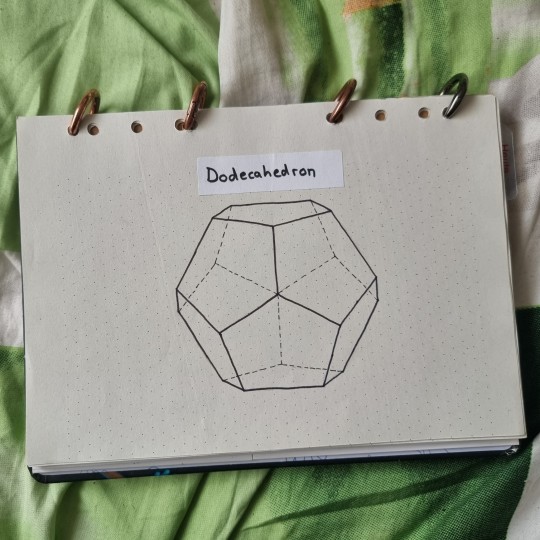
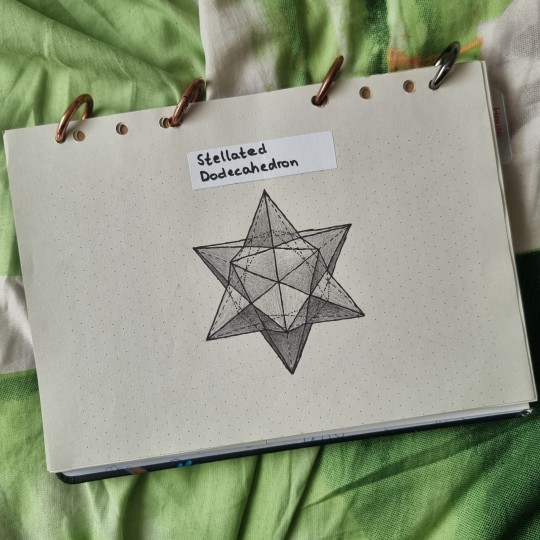
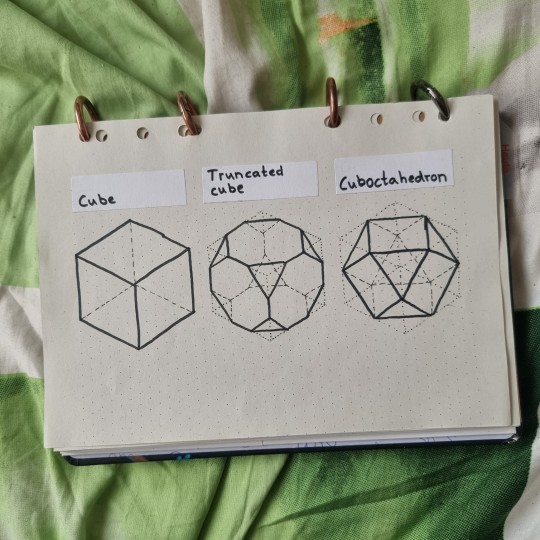
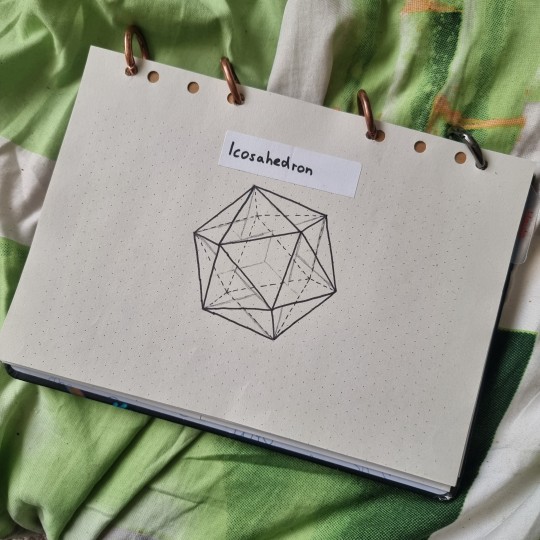
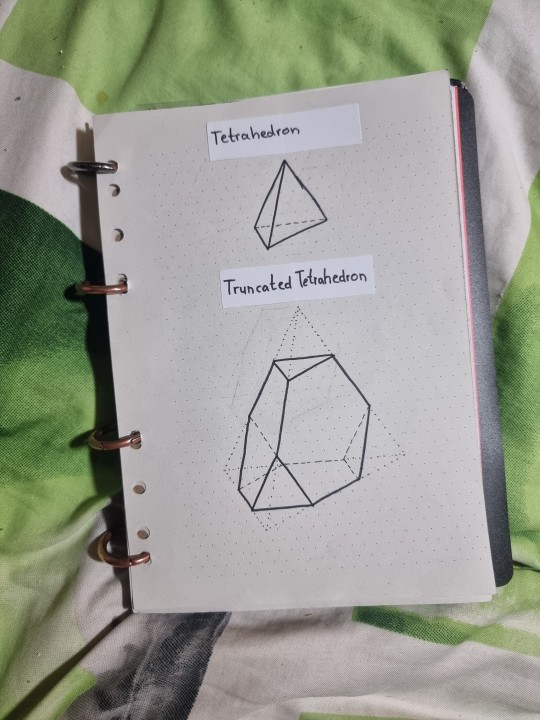
Drawing polyhedra on dotted isometric paper is so calming. One does not need to use a ruler or a compass. Instead one can just count dots to determine the length, and play around with the angles.
#geometry#isometric grid#isometric paper#isometric dot paper#isometric#dodecahedron#stellated dodecahedron#cube#truncated cube#cuboctahedron#icosahedron#mathy art#polyhedron#polyhedra#platonic solids#polyhedra compounds#compounded polyhedra#archimedian solids#archimedian solid#3d#drawing#perspective#polyhedra in perspective#perspective drawing#shapes#forms#calming#illustration#knottys art#math art
137 notes
·
View notes
Text
Polytope info card of the Truncated Cuboctahedron

Today I finished this friend-shaped archimedian solid.
I drew the tiny drawing in the down right corner of the card and resized it with my printer.
The drawing:
I drew this Truncated cuboctahedron in an isometric projection and used my beloved isometric dot paper.
To start with the truncated cuboctahedron I started to draw a cube (with pencil).
Then I altered the cube by drawing a cuboctahedron in it (with pencil as well). I truncated th vertices of the cube like in the depiction below:
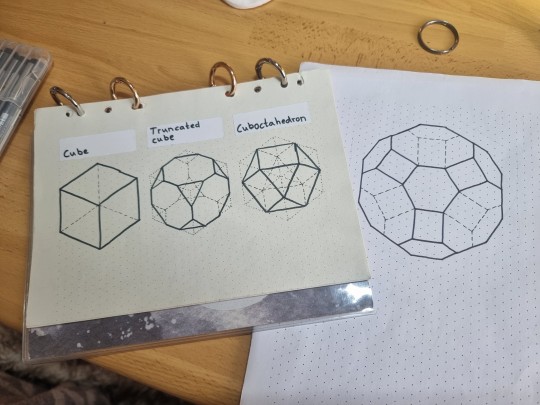
Then I altered the cuboctahedron drawing with another truncation - resulting in the truncated cuboctahedron shape.
[For clarification: I later erased the pencil lines of the cube and cuboctahedron, because it became messy and these lines were just there to help in the drawing process.
For the photo I laid pictures of a cube and cuboctahedron besides the truncated cuboctahedron drawing to show the similarity between these shapes - and present the principle of truncation visually.)
#polytopes#polytope#polyhedra#polyhedron#cuboctahedron#truncated cuboctahedron#archimedian solid#archimedian solids#geometry#math#mathy stuffy#knottys math#polytope info cards#math art#mathy#mathematics
73 notes
·
View notes
Text
Truncated Icosahedron

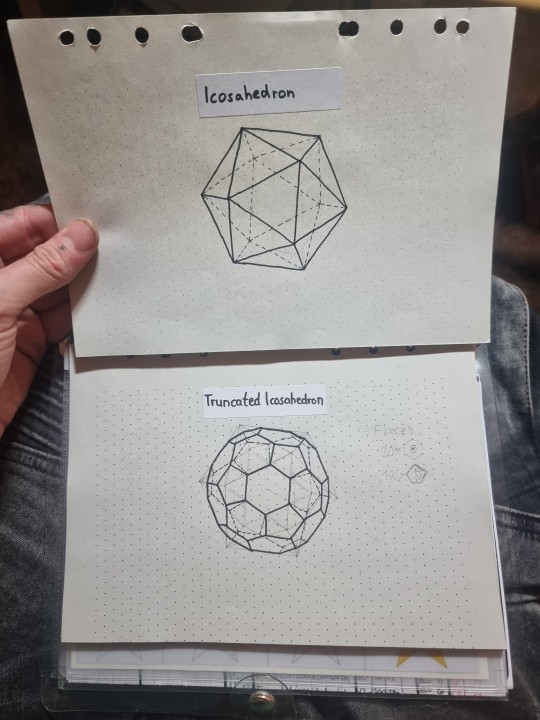
when my brain becomes more functional and less exhausted again i would like to make some tutorials about how to draw polyhedra on isometric grid paper.
I enjoy drawing truncated solids, because you can literally draw one polyhedron into another and just erase the lines of the previous polyhedron.
#truncated icosahedron#icosahedron#platonic solid#archimedian solid#polyhedron#polyhedra#geometry#geometric#isometric#knottys art#knottys mathy stuffy#math#art#artsy#knotty et al
49 notes
·
View notes
Text
Truncations of the cube
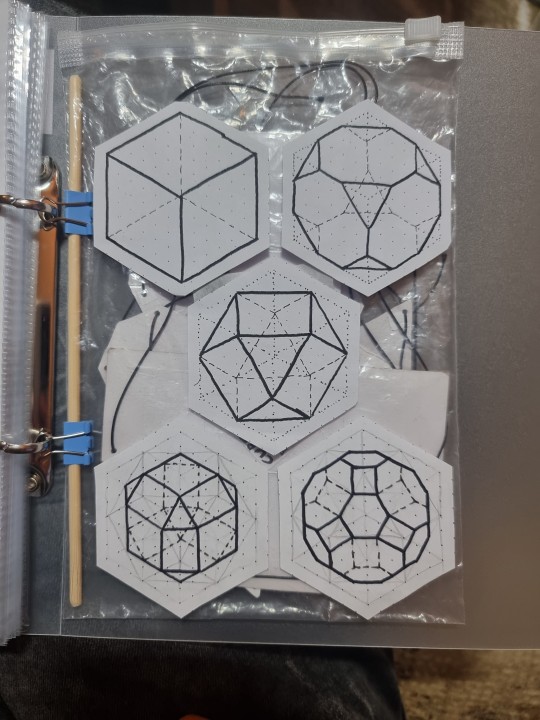
This is what I have done with my spare shape drawings...
Depicted are different truncations of the cube - and the cube itself.
The polyhedra are (from left to right and from top to bottom)
- Cube
- Truncated cube (Cube's vertices get cut off to one third of each edge.)
- Cuboctahedron (Cube's vertices get cut off to a half of each edge.)
- Rhombicuboctahedron (Cuboctahedron's vertices get cut off to a half of each edge.)
Truncated Cuboctahedron (Cuboctahedron's vertices get cut off to a third of each edge.)
#polyhedra#polyhedron#geometry#cube#truncated cube#cuboctahedron#truncated cuboctahedron#rhombicuboctahedron#hexahedron#archimedian solids#archimedian solid#shapes#shape#mathy#knottys mathy art#mathy art#math#mathblr#truncation#truncated#truncate
47 notes
·
View notes
Text
Tiny hexagon-spiral booklet with friend-shaped friend shapes of joy (platonic and archimedean solids drawn in isometric projection)
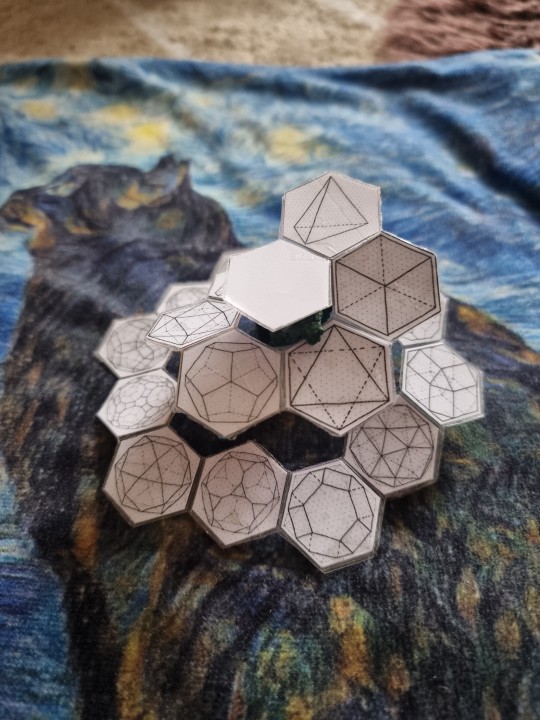
Front- and backside:

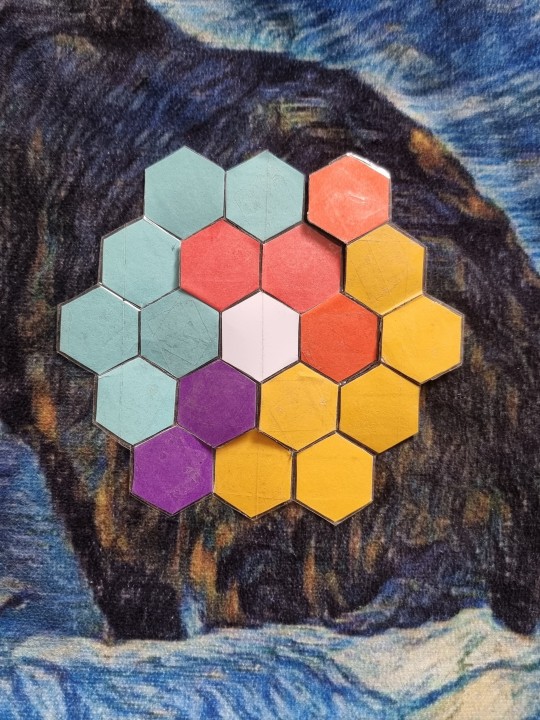
Laying at a stone to make the hexagon-spiral booklet appear more plastic:


This booklet can be folded into a tiny hexagon with moderate thickness:

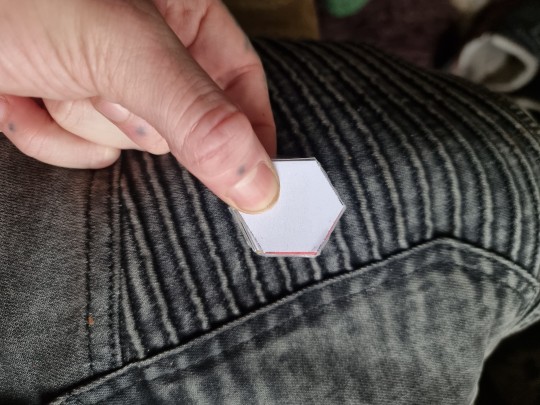

#polyhedra#polyhedron#hexagon#hexagonal#spiral#booklet#tiny booklet#pattern joy#math love#math passion#geometry#pretty shapes#shapes and colors#hexagons are the bestagons#knottys art#math#archimedian solid#archimedean solid#platonic solid#platonic solids#isometric#isometric projection#shapes#knottys math#visualized math#crafts#crafting#diy
50 notes
·
View notes
Text
Polytope card of the Truncated Icosidodecahedron

#damn - drawing dat graph on a tiny 3x3cm square was challenging#truncated icosidodecahedron#archimedian solid#archimedian solids#polytope cards#polytope info cards#polyhedron#polyhedra#polyhedron info cards#geometry#math#mathematics#mathy#knottys math#info cards
45 notes
·
View notes
Text
Polytope info card of the Snub Cube
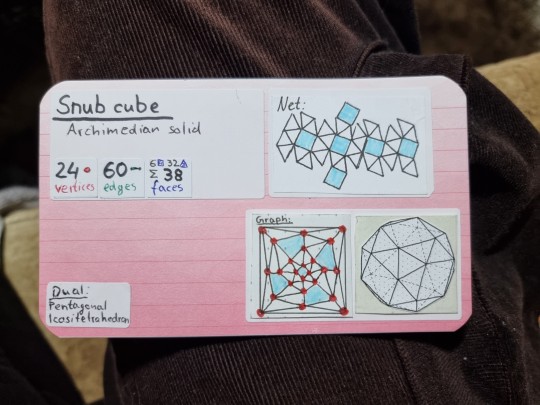
Today's shape was the archimedian solid "Snub cube".
The snub cube has 38 faces in total - 6 square faces and 32 triangular faces.
It has 60 edges and 24 vertices.
Each vertex is met by 4 triangle faces and 1 square face.
A snub cube is an alteration of a truncated cuboctahedron.
The drawing:
For the isometric projection drawing I started with a truncated cuboctahedron, and continued to alter the truncated cuboctahedron's octagonal faces into square faces.
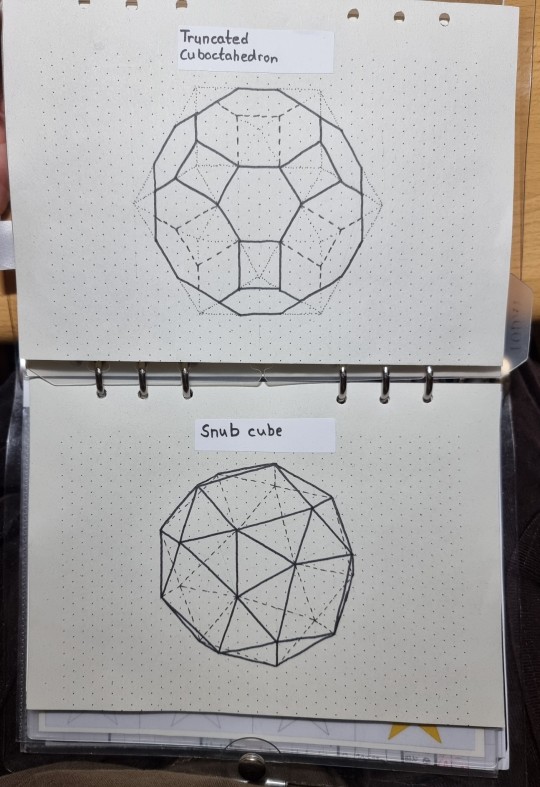
#polyhedra#polytope info cards#polytope#polytopes#polyhedron#archimedian solids#archimedian solid#snub cube#snub cuboctahedron#truncated cuboctahedron#cuboctahedron#truncation#mathy stuffy#math stuff#math#knottys math#knottys mathy stuffy#mathematics#math joy#math passion#geometry#geometric drawing#shapes
36 notes
·
View notes
Text

I drew that rhombicuboctahedron from a cuboctahedron.
I also collected all polyhedron drawings from this notebook in an own file - and started to add infos such as number of vertices, edges and faces to each page. I will also add further infos and stick them on the pages once I know how I want the infos to be placed and which infos I furtherly want to add.
I want to add polyhedron nets as well.
#polyhedron#polyhedra#rhombicuboctahedron#archimedian solids#archimedian solid#geometry#mathy#knottys math
23 notes
·
View notes
Text
So, today I finished drawing the Archimedean solids.
(and I also realized I wrote "Archimedean" wrong all the time... )
Dats all dese shapes I have drawn, resized with my printer to make them fit in their tiny 3x3cm spots on dat sheet I made:

(Now we could make shape soup, shall we? And then we might call dat soup "shape soup Archimede speciale" /silly)
#archimedean solid#archimedian solid#shapes#geometry#shape#polyhedra#polyhedron#isometric#math#isometric projection#too lazy to tag all 13 shapes#shape soup ingredients for archimede speciale#shape soup
24 notes
·
View notes
